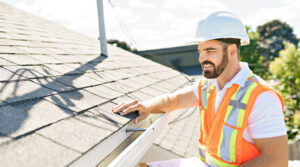If you are looking for a way to protect your roof, the first step is to conduct regular roof inspections. This will help you know if there are any problems with your roof, including leaks, blistering, curling, and buckling.
 Sagging roofs can be a real threat. They can cause structural damage and even collapse. This can be a very dangerous and costly situation. You can get a professional to inspect your home for signs of sagging. However, you might want to check for a few signs yourself first. The best way to identify a sagging roof is to look for a sagging area on the flat portion of the roof. Look for areas with a dip, bowing, or humps. If you notice these, then you may have a sagging problem.
Sagging roofs can be a real threat. They can cause structural damage and even collapse. This can be a very dangerous and costly situation. You can get a professional to inspect your home for signs of sagging. However, you might want to check for a few signs yourself first. The best way to identify a sagging roof is to look for a sagging area on the flat portion of the roof. Look for areas with a dip, bowing, or humps. If you notice these, then you may have a sagging problem.
A sagging roof can be caused by too much weight, too many layers of shingles, or poor installation. Additionally, it could be the result of moisture or water damage. Sagging roofs can also be a sign of foundation problems. This is a more extensive issue and could affect your entire home. You should call a professional if you find any signs of sagging in the upper levels of your home.
Look for signs of buckling, curling, or blistering. If you’re planning on installing a new roof, or if you’re considering a replacement for an existing roof, you may want to look for signs of buckling, curling, and blistering. These signs can indicate that your roof has weak spots, which could lead to leaks. Buckling is one of the most common signs of deterioration. This deterioration can occur when shingles are improperly installed, or if the fasteners are not strong enough to hold up the weight of the roof.
Curling can also happen when shingles are improperly stored before installation. Poor quality materials can cause it, or it can be the result of improper ventilation in the attic. Blisters are a sign of moisture that’s trapped between shingles. You can see this by looking for bubbles or bumps on the surface of the shingle. They can be a warning of water damage in the attic or in other parts of the home. Mold can be an indicator of a more serious problem, such as a poor foundation or drainage system. Shingles that have gotten moldy will not be able to protect your home from the weather.
Roof leaks can be a source of water damage and can result in mold growth. Identifying and fixing a leak can save your home from further damage. While the task may seem daunting, you can find out how to do it by following some simple tips. You can use a flashlight to spot areas of damage on your roof. Be sure to look for the signs of a leak: missing roofing materials, damaged insulation, and other damage.
If you are looking for a roof leak, you can also check for signs of moisture in your attic. A musty odor and dark spots are common indicators of water damage. In addition to checking the attic, you can check out your roof’s eaves and flashing for evidence of a leak. These are often the most vulnerable areas of a home. When you see the leaking sign, make sure to call a professional to find the source. It is a good idea to document any damage in a photo for insurance purposes.
Insurance companies often require roof inspections before purchasing or renewing a policy. This is to ensure the roof is in good condition. Some insurers will offer a discount for having a roof certified. A roof can be susceptible to damage from wind, rain, hail, and other hazards. Keeping it in good repair can make it last longer. It can also help prevent serious issues.
Insurance companies will not cover any damages that occur if the roof is not in good condition. They will also raise your premiums if the roof is in bad shape. To avoid these problems, be sure to have a professional perform a roof inspection. Homeowners should have a roof inspection every few years. It will help keep your home safe and protect you. Having the roof inspected can save you thousands of dollars over time. The best way to get a roof inspection is to call a roofing company. These companies will provide a written report detailing the condition of your roof.
